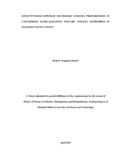| dc.description.abstract | The world is faced with an increasing threat of violent extremismthat is preceded by radicalisation processes. Kenya faces this threat from Al-Shabaab who recruit Kenyan youths to join their ranks and executive terror acts internally. Secondary and university students have become their target in Kenya, which formed the foundation of this study. The study aimed to investigate the effectiveness of public secondary school preparedness in countering radicalisation towards violent extremism in Kajiado, Kenya. Kajiado County neighbours Nairobi County, thus sleeper cells potentially reside in it. Specifically, the study determined the level of knowledge on factors inducing students to violent radicalisation, examinedthestrategiesimplementedto addresstheemergingthreatofrecruitmentandradicalisation and examined the challenges faced by the schools‟ management in their efforts to counter violent extremism radicalisation. Kajiado County has 158 public secondary schools from which the target population was chosen.Thus, the targetpopulation includedall public secondary school principals (158), teachers (2078) students (22,351), Sub-County Education Officers (5) and Chiefs (61). Simple random sampling and purposive sampling were used in the study. The sampled size was 16 principals, 207 teachers,112 students,6 Chiefs and 1 Subcounty Director of Education. Data was collected by the use of questionnaires,interview schedules and FGD guides. The study usedSPSS version 25.0for the analysis of the data and the results were presented in tables andfigures. The results showed that teachers 36.1% confirmed the existence of radicalisation amongst students. Poverty 60% and unemployment 57.1% were the main contributors to students‟ radicalisation. Moreover, student susceptibility to radicalisation was amplified by frustrated ambitions hence radicalisation toward violent extremism. A continuous scenario of student dropoutwas significantly attributed to radicalisation toward violent extremism (χ2 (1) = 14.23, p< .001).A multi-sectoral approach to countering radicalisation is an acceptable strategy endorsed by the schools to eliminate radicalisation toward violent extremism. Inadequate parental support for most students were also contributorstostudent radicalisation toward violent extremism. In conclusion,radicalisation was happening in public secondary schools in Kajiado County; students were justifying the use of violence as a means to solve their issues;causes of radicalisation among the students were poverty, marginalisation, unemployment, divisive religious ideologies and ever-increasing corruption; the strategies for countering radicalisation in schools were not operational hence school management was not able to effectively counter radicalisation among their students.Recommendation: teachers should be trained to promote counter violent extremism in schools. The strategies developed by the Ministry of Education on Countering Violent Extremism should be fully operationalised in schools in Kenya. | en_US |

